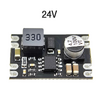An acquaintance M is good at the practical side of building electronic circuits, but maybe not so good on the theory, so a friend used to help him with that. The friend wasn't able to help with this circuit, and M went ahead with building it anyway.
It is a two rail power supply for a 20W stereo power amplifier. Toroidal transformer, full-wave rectifiers and capacitors. He intended to use Zener diodes with resistors to stabilise the output voltage, but didn't know how to decide on their resistance.
He asked me. It looked a bit crude to me and I was concerned that there would be a lot of power dissipated across the Zeners. It's worse than I thought. Since the transformer is 30-0-30, the output of the rectifier and capacitors will be the peak voltage of 41V and since the output should be 24V, there will be a 17V drop which will mean about 14W dissipated per rail. Not sensible.
I would replace the transformer with something more appropriate (24-0-24?), but since he has paid over £100 for the transformer, I suspect he would be reluctant to do so.
Instead of the Zeners, he could use regulator chips like LM317/LM337, I think that the chip controls the voltage without dumping it as heat, so the 17V drop wouldn't be a problem, but I'm not sure, am I correct?
It is a two rail power supply for a 20W stereo power amplifier. Toroidal transformer, full-wave rectifiers and capacitors. He intended to use Zener diodes with resistors to stabilise the output voltage, but didn't know how to decide on their resistance.
He asked me. It looked a bit crude to me and I was concerned that there would be a lot of power dissipated across the Zeners. It's worse than I thought. Since the transformer is 30-0-30, the output of the rectifier and capacitors will be the peak voltage of 41V and since the output should be 24V, there will be a 17V drop which will mean about 14W dissipated per rail. Not sensible.
I would replace the transformer with something more appropriate (24-0-24?), but since he has paid over £100 for the transformer, I suspect he would be reluctant to do so.
Instead of the Zeners, he could use regulator chips like LM317/LM337, I think that the chip controls the voltage without dumping it as heat, so the 17V drop wouldn't be a problem, but I'm not sure, am I correct?



